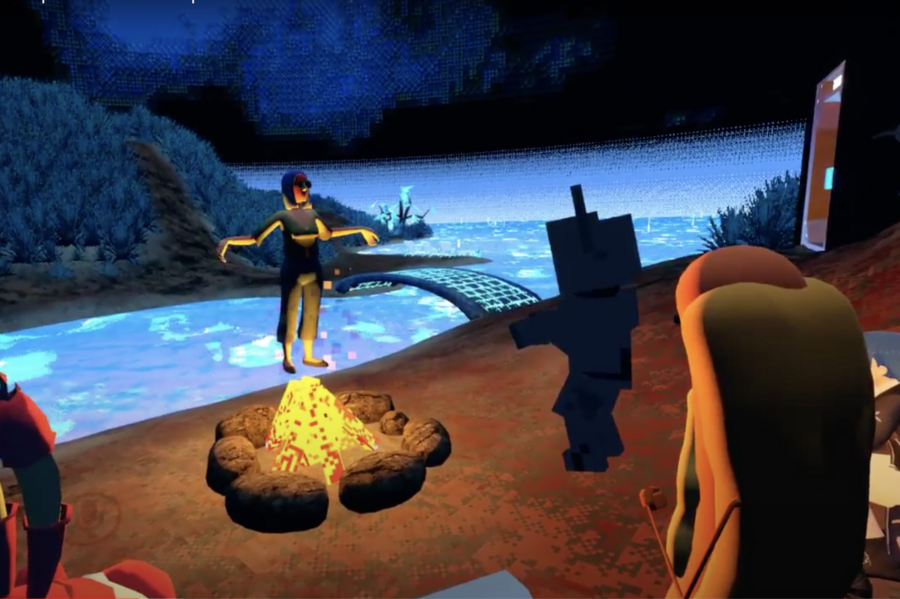Imagine meeting friends around a campfire, having drinks, and holding hands while dancing. This scenario is all but impossible during these times of social distancing—except in the virtual realm. With Virtual Reality (VR), you can create (or at least envision) a physical presence beyond that of any two-dimensional Zoom meeting.
“The biggest difference is that there are no boundaries in VR,” said Michelle Cortese, a VR product designer at Facebook and the guest instructor for a new course at NYU Tisch School of the Arts’s Brendan Bradley Integrative Technology Lab.
The course pairs students with professional technologists and artists to explore questions about the future of live performance and technology. Along the way, they collaborate on real-world projects that incorporate virtual and augmented reality, 360-degree capture, and more. (That communal campfire gathering was among the results.) And all of this happens remotely, with the entire class taught in VR using Oculus Quest headsets.
In other words, the timing was unusually fortuitous to embrace this cutting-edge, remote-learning-friendly technology. “In the middle of this semester, this whole pandemic happened,” said Brendan Bradley, a Tisch alum himself, had been working on the idea of this lab for the three years. “And instead of having to simulate the distance, they were actually experiencing and living that distance.”
NYU Tisch students Cyrus Rosenberg, a senior studying game design, and Michael Morran, a junior studying drama, are among the students collaborating in the class. They said they consider themselves lucky because the infrastructure was already in place.

“In VR, I liked the idea that everyone is on equal footing,” Rosenberg said, referring to the audience as well as the actors. “We’re all wearing the same goggles, there are no specific seats, so we all have the same abilities handed to you. Our first performance worked best because it was themed around this idea that the exact same thing that’s happening to the actor could happen to the audience.”
Morran is also doing studio classes over Zoom via the Brendan Bradley Integrative Technology Lab, and he can feel the difference between the two experiences. Being able to use VR to be present through a virtual avatar is a big step up from the 2D face-to-face experiences of Zoom, he explained.
Cortese, the course instructor, said the participants’ physical appearance is just the beginning. She believes that creators and performers have been bound by constrictions they assume they have as they try to come up with new ideas. But if there are no monetary or spatial limitations, she said, anything is possible.
“You’re maybe less likely to set something on Mars,” Cortese explained. “In VR, where everyone is costumed in an avatar, none of you need to be humanoid. Everything that we thought we needed to do is now out the window.”

The idea for the class and the technology lab began well before there was any talk of COVID-19 or social distancing, of course. “The entire time I was here, I was a part of a theatre company that was entirely student-driven, and we used to do really experimental things,” said Bradley, who has built a steady film, television, and commercial career (including working as the national spokesperson for Staples) after graduating from Tisch in 2005. “When I was in a position to give back, I approached the university about offering a grant for a new student-driven, technology-incorporated course.”

Three years ago, Bradley met with Tisch drama chair Rubén Polendo to discuss creating a course that included a lab where students can experiment with new technology like VR. They first started creating what they called the Innovation Lab, an extracurricular space for students to come together, as an experiment to gauge student interest.
“I always take the lead from students,” Polendo said. “After these collaborations that we did, students leaned into it, and it became a really cool idea to involve other leaders in the field around innovation.”
He and Rachel Friedman, a program administrator and adjunct instructor at NYU Tisch, helped develop these broader ideas into a class, curate the guest instructors, and bring in industry partners. The first class began in January with an eye toward introducing the students to a different technology and having them find ways to integrate it into live performance.
“The idea for the course stemmed from this desire to have students thinking ahead to the future of entertainment and technology and what those intersections might look like,” Friedman said. “It was totally circumstance or luck that the students happened to have just started a VR section with Facebook’s Oculus team and had just gotten their headsets the week before we went online.”
The goal this semester’s curriculum isn’t product oriented and will not culminate with a final performance. Instead, the students are workshopping and exploring the technology so they can come up with their own pitch on merging technology and live performances. In fact, BroadwayHD also worked with the class to experiment with the different ways technology could be used to enhance the digital capture or live streaming of live productions.
“The marriage between the technology and the theatre has been ongoing,” said BroadwayHD co-founder Stewart Lane. “Being sheltered like we have been because of the virus, we’ve just expedited that process by about 10 years.”
Polendo is similarly enthusiastic about the prescience of these capabilities. “Who knew it would become such a vital moment?” he said. “The timing is extraordinary!”
Utkarsha Laharia is a Goldring Arts Journalism graduate student at Syracuse University.


